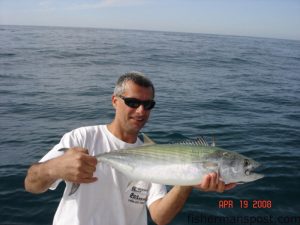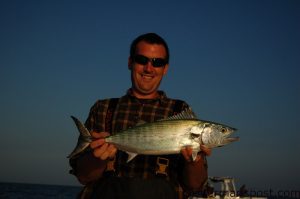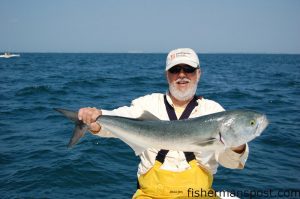Planning on Bonito 2009

Capt. Jim Sabella, of Plan 9 Charters, with an Atlantic Bonito he caught on the fly rod during a bonito blitz in mid-April. The fish were chasing schools of tiny baitfish around Diver's Rock off New River Inlet.
What has speed, stamina, stripes, and brings nearshore anglers the first opportunities at pelagic gamefish after a long winter full of far more wishing than fishing? OK, for many anglers in the know, this riddle isn’t too difficult to solve, but Atlantic bonito still swim under the radar of many fishermen in the area, surely due at least in part to the short time they’re available off our coast.
Each spring, the bonito arrive off our shores to feed voraciously on schools of small baitfish around wrecks, rocks, and ledges within a few miles of the beach, and, as suddenly as they appeared, the fish move on, following the water temperature and forage up the coast. The short window of opportunity for local anglers (usually lasting a few weeks to a month) heralds the beginning of spring fishing for anglers who like targeting speedy, surface feeding gamefish, as spanish mackerel, false albacore, and kings begin feeding in the same areas soon after the bonito clear out.
The last weeks of March and beginning of April are typically when the bonito show up, and last spring I had my ears open for word of their arrival, knowing that if I missed them, it would be another year before the opportunity came again. I’d been hearing about these diminutive tuna-relatives for several seasons without actually going out to chase them, and resolved that last spring would be my time to connect with one. After hearing about a solid bite in early April, I called Capt. Jim Sabella, of Plan 9 Charters out of Wrightsville Beach, to put a trip together before the fish disappeared.
Jim and friend Billy “Ice Cream Man” Manger had had a banner day on the bonito the weekend before, landing double digit numbers (even a few on fly), and I needed to get in on the action. Jim was happy to accommodate, and I rendezvoused with the pair one pre-dawn morning the next week at his house in Hampstead. Jim usually fishes out of Wrightsville Beach, but the bite had been much better (bordering on epic) out of New River Inlet, north of Topsail. So we utilized the mobility that comes with trailering a boat and hauled his 19′ Maycraft to New River Marina for the best shot at the fish.
After clearing the inlet, we headed a few miles offshore to the edges of the large, live bottom area known as Diver’s Rock, and began the hunt. We didn’t see any of the explosive surface feeding that betrays the presence of the bonito schools at first, so we entered search mode, deploying a pair of Yo-Zuri Deep Divers, lipped plugs that dig down 10′ or so, and began trolling just as the sun was working its way over the horizon.

Max Gaspeny with an Atlantic bonito (his first) caught while fishing with Capt. Jim Sabella. The fish fell for a small Maria Jig while casting to breaking schools of fish at Diver's Rock off New River Inlet.
“It’s early, we’re not seeing anything on the surface, and there’s not much on the scope to excite me yet,” Jim said, keeping an eye on his color bottom machine as we made a course towards the main part of Diver’s Rock, waiting for some action on the plugs or something to happen on the surface.
“This water’s 66 degrees,” the captain continued, eyes moving between the water ahead, the bottom machine, and the rod tips bouncing under the resistance of the Deep Divers. “This’ll probably be the last week the bonito are here, and really, I wouldn’t be surprised if somebody catches a spanish mackerel today.”
There were a quite a few “somebodies” out there, as word of the hot bite had seemingly spread to nearly every angler in the region with a boat capable of leaving the inlet. Several other anglers had been launching with us before dawn and accompanied us out towards the rock, but at least a dozen more had shown up in the few minutes we’d been trolling, and we could see the spray coming off several more bows making a beeline from the inlet to the fleet forming around Diver’s Rock.
Shortly after his observation about the water temperature had made me wonder whether the fish had moved on yet, something caught Jim’s eye ahead of the boat, and he issued an order. “Wind ’em up!” we heard, and Billy and I commenced to cranking in the Yo-Zuri plugs double time.
As soon as we had the plugs out of the water, Sabella punched the throttle and put the Maycraft on plane for a short distance, pulling back on the stick as we closed in on an area of frothy water just offshore of most of the fleet. As we glided towards the disturbance, I was thrilled to see not one, but at least a half dozen of our quarry carried airborne by their wanton feeding. The first fish were followed by many of their schoolmates, and it was immediately apparent that we were on a sizeable body of fish.
As we closed into casting range, Jim handed me a medium spinning combo rigged with a tiny 14 gram Maria Jig and I could now see the tiny shimmering baitfish roiling the water as the bonito balled them up into a tight, panicked mass. As I made my first cast, the bonito continued slashing at the fish on the surface and shooting into the air above the chaos. After a winter spent chasing an odd speckled trout and little else, this was what I’d heard about and come for, but it was hard to believe the intensity of the action when it was just a few yards in front of me.
Unfortunately, the Ice Cream Man and I were each only able to get off a few casts before the school disappeared, driven into the depths by several other boats who’d seen the commotion, then run over and practically on top of the fish instead of slowing down and stealthily intercepting the feeding school, as Jim had done.
I found it hard to believe that I could cast a lure into a group of fish feeding with such abandon and not get a bite, but I could at least take comfort that Billy, a bonito veteran, hadn’t hooked one either.
I was annoyed at the other boats for driving down the school, but by the time I could say anything about it, Jim had spotted another surface frenzy just a few hundred yards away, and we were closing on the fish again. I was a little less taken aback at this second school, and got another cast off, working the Maria jig back and willing a fish to inhale it.
Another cast at hundreds of voracious fish had come up empty, and after the lure splashed down again beside the feeding bonito, Jim had a little advice. I’d been working the lure like a Gotcha plug, with sharp, frantic jerks of the rod. Not wanting the bait to sink past the feeding fish, I had also been starting my retrieve as soon as it hit the water.
“Let it sink a good bit, then just reel it back to you pretty quickly,” he explained while the fish continued crashing through the water’s surface. “There’s plenty of fish under the ones on top, and that lure’s got enough of its own action that you don’t need to work it much. I don’t think the bonito like that jigging business too much.”
I followed instructions, letting the jig sink for a languid 10-count, then began reeling it back rapidly without a pause. Lo and behold, it only took about 10 turns of the reel handle before the lure came to an abrupt halt, and line began pouring off the spinner’s spool.

Billy Manger with a monster chopper bluefish around 13 lbs. that he hooked beneath a schools of feeding bonito while fishing near Diver's Rock with Capt. Jim Sabella.
Billy and I had hooked a few small bluefish on the Marias before I connected with the bonito, and this fish left no doubt that it was something else entirely. The fish’s initial run seemed endless, especially given the size of the fish I’d seen airing out, but it finally began to slow. As the first run subsided, I was able to work my adversary just a few yards back towards the boat before it decided it had had enough, and took off on another lightning run, this one mercifully shorter than the first.
The bonito is shaped much more like a tuna than a mackerel, and the extra body depth seems to make it fight more like one, too. After the fish’s strong opening runs, I was able to coax it a little closer to the boat, but it refused to come the final distance, tearing off line in short bursts, matching every yard or two I would gain and making the battle feel like it had reached a stalemate. When I finally thought I’d broken its will, the fish began the death circles any angler who has fought a yellowfin or large king mackerel is familiar with, putting up a final struggle that ended when Jim interrupted a circle with his landing net.
A common experience for many fishermen on their first encounter with a hard-fighting species, I thought that I’d been fighting a much larger fish, but this first bonito would have tipped the scales at no more than three pounds. Instead of disappointment at its size, though, I was elated to have boated my first Atlantic Bonito in the boat, marveling at the horizontal stripes, vertical bars, and mouthful of intimidating (but not leader threatening) teeth that make this fish instantly distinguishable from any other in the mackerel and tuna family.
After a few quick photos, Jim slid the fish into his cooler, as the bonito are not only hard-fighting and beautiful, they’re excellent table fare as well. With the first fish on ice and the school we’d been working long since pushed down, we took off for another patch of disturbed water made even more obvious by the sun flashing off the bonitos’ flanks as they came out of the water.
It didn’t take long for a repeat performance, now that I had Jim’s retrieve down, and I was soon fast to a fish putting up an even harder battle than the first one had. Billy hooked up, too, but his fish came unbuttoned while I battled mine, and with the school long gone, he kept casting but without much of a target.
This fish even took longer than the first, but after another dogged back and forth battle on the light gear, I brought a second bonito to Jim’s waiting net. This one indeed proved stouter than the first, and would easily top the five pound mark. The second fish joined its companion in the box post photograph, putting the makings of several solid meals aboard the boat, and my quest for a bonito was complete twice over.
Though several sources had told me the bonito were excellent on the table, I’d never caught, and thus, never prepared one, so I sought the captain’s advice on preparation.
“Oh you can do about anything you could do with any other tuna with it,” Jim said, repositioning the boat over the seafloor ledges where we’d had our first hookups. “You can loin them just like a little yellowfin and grill the loins, make sushi or sashimi out of it, whatever.”
I’m pleased to report I later tried a variety of preparations, including bonito sashimi and grilled and broiled bonito loins. None failed to disappoint.
After we boxed our second fish, the surface activity seemed to have ended, as the bonito usually stop chasing bait on the surface when the boat traffic gets heavier as the morning wears on.
“These fish are keyed in on the structure,” he explained, eyeing the color scope for a depth change. “We can do some vertical jigging over the ledges where we found them this morning and hopefully hook a few more. I’ve actually caught a lot more fish after the schools have been busting than when they’re going at it on top.”
The bonito, however, seemed to have developed lockjaw, though we did land several more blues and small sea bass working the jigs near the bottom. We decided that our mission was already accomplished after working several spots on the ledges without a bonito, Jim pointed the bow at the beach, and since the run was so short (3 miles) we decided to put the Deep Divers back out and troll towards the hill.
After trolling for a few minutes, we were surprised when a school of fish began churning the water just in front of the boat. Billy and I quickly fired off casts, although mine landed a bit short, and Billy’s rod nearly instantly doubled over. Unlike the bonito, which tended to run deep, this fish took off on top with a vicious run. A fellow boat who’d come up from Wrightsville and trolled all day had hooked several big bluefish in the 8-10 lb. class, and Jim suspected that’s what it was.
“I think that’s one of those big choppers,” he explained, following the fish with the boat. “Those were bonito feeding on top, but the blues will sit down underneath them.”
Sure enough, the mystery fish solved itself, as a tremendous bluefish came out of the water with a head-shaking jump mid-run. The blue was obviously of a different class than the few we’d caught earlier, and it took the Ice Cream Man on a number of laps around the boat, fighting longer than either bonito had, but finally the landing net stood in its way and the blue swam right in.
Lifting the largest bluefish I’d ever seen into the boat, even Jim, a native New Yorker who’s seen plenty of big blues in his time, became animated.
“This thing is huge,” he said while taking measurements of the fish. The big blues are certainly edible, but no comparison for bonito on the table, and Billy and Jim decided to let it go after a quick series of photos.
After Billy’s battle with the mega-blue, we decided that with our objective complete and afternoon obligations looming, we’d head for the marina. After we got back to shore, Jim plugged the length and girth into a formula that pegged the blue at just over 13 lbs., a chopper indeed.
Jim starts looking for the bonito every year when the water hits 60-63 degrees, and he finds most of his fish around structure 2-5 miles off the beach, like Diver’s Rock off New River and the Liberty Ship and 5 Mile Boxcars off Masonboro Inlet. They generally stick around until the water hits 66 or so degrees before moving along. The waters off Wrightsville and Topsail are hotspots, but the fish have the potential to show up at nearshore structure anywhere from Myrtle Beach to Morehead.
After the bonito head for cooler waters, Jim targets king and spanish mackerel, cobia, and bottom fish in the ocean and red drum and flounder inshore. He fished as a youth on Long Island, honed his skills working on sportfishing and party boats up north, and has been running his own boat in southeast NC for the past 7 seasons. This season he’s upgraded from his 19′ Maycraft to a brand new 21′ Mako in order to carry more anglers and extend his offshore fishing opportunities.
The spring bonito run is just around the corner, so if you’d like to shake off the winter blues with line searing action on some of spring’s first, fastest, and tastiest arrivals, give Capt. Jim Sabella a call at (910) 367-2224, or visit his website at www.topsailfishingcharters.com for more info.





